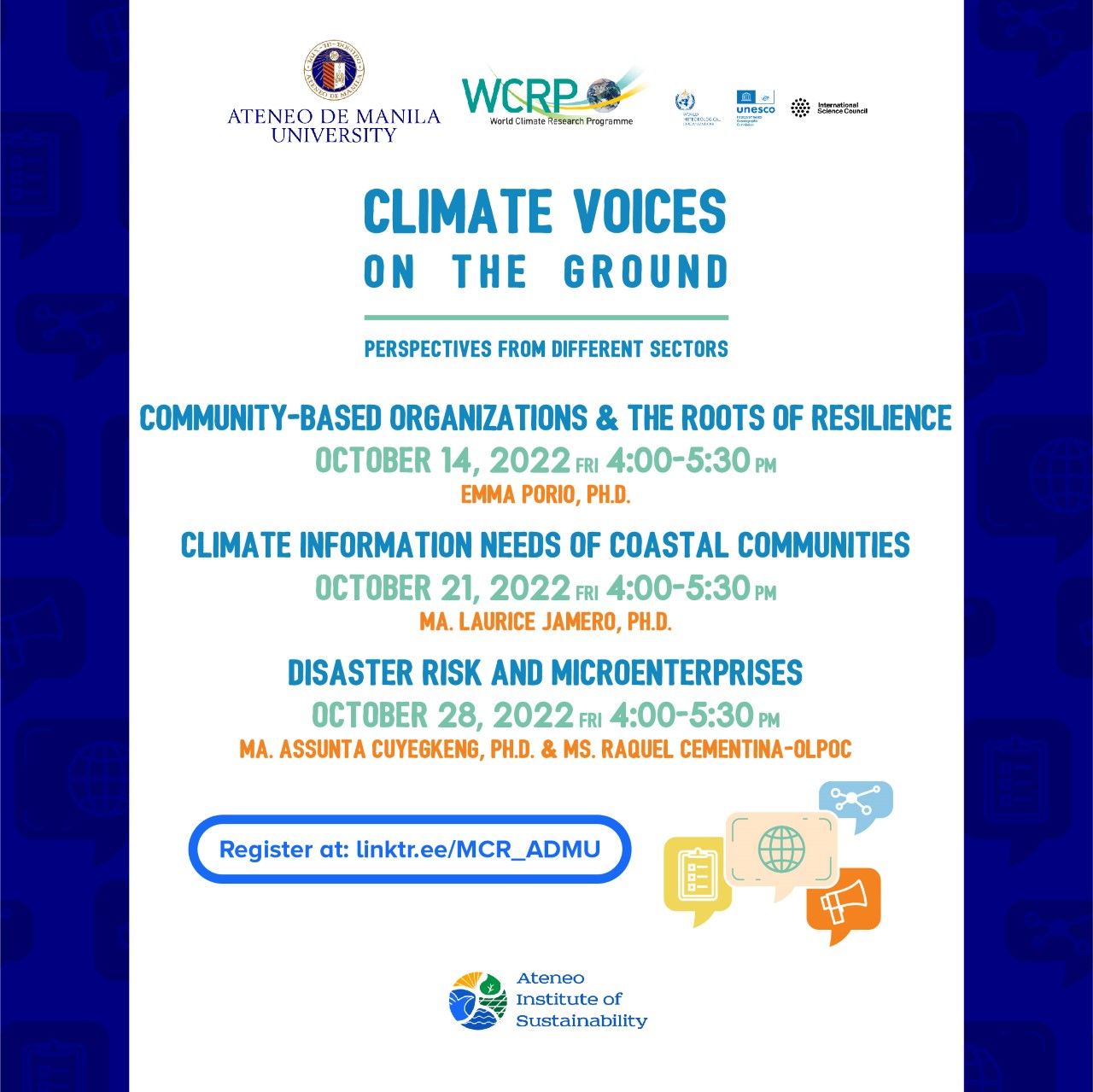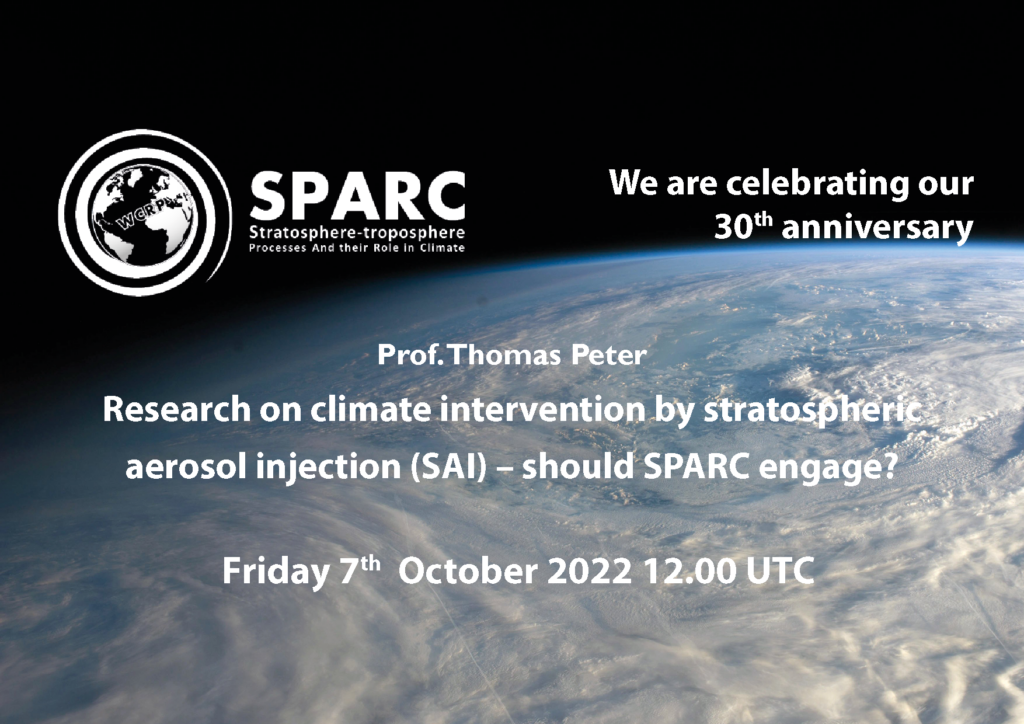| In their most-recent newletter the YESS community is sharing the latest news. The YESS community has been present in different international and regional activities around the world. Those include panels, conferences and ECR side-events at workshops. The newsletter reflects the enthusiasm and energy their active members put in to construct a wider and more present network. Early Career Researchers always welcome to join YESS in this adventure by becoming more active in the community (e.g. by joining a Working Group)! The newsletter provides an insight in the following activities: New perspective article on CMIP data and survey for the community YESS involvement in the GEWEX Pan-GASS Meeting YESS at WWRP Symposium YESS activity at the VI Convection-Permitting Climate Modeling Workshop YESS at EMS 2022 annual meeting YESS at SRI 2022 Science highlights |
Category Archives: News
SPARC Science update: 20 September – 26 September
A selection of new science articles from the past week of interest to the SPARC community (a SPARC Office choice).
Stratospheric Aerosol Composition Observed by the Atmospheric Chemistry Experiment Following the 2019 Raikoke Eruption. By C.D. Boone, P.F. Bernath, K. Labelle, and J. Crouse in the Journal of Geophysical Research: Atmospheres.
A realistic projection of climate change in the upper atmosphere into the 21st century. By I. Cnossen in the Geophysical Research Letters.
The Role of Convective Up- and Downdrafts in the Transport of Trace Gases in the Amazon. By R. Bardakov et al. in the Journal of geophysical Research: Atmospheres.
An Examination of the Recent Stability of Ozonesonde Global Network Data Date Updated: 30 August 2022. By R.M. Stauffer et al. in Earth and Space Science.
Water vapor injection into the stratosphere by Hunga Tonga-Hunga Ha’apai. By H. Vömel, S. Evan, and M. Tully in Science.
Response of tropical convection over the western Pacific to stratospheric polar vortex during boreal winter. By F. Wang, R. Huang, and L. Wang in the International Journal of Climatology.
New webinar: WCRP My Climate Risk: Climate Voices on the Ground
The My Climate Risk (MCR) – Ateneo de Manila University (ADMU) Regional Hub, through the Ateneo Institute of Sustainability, invites you to the first of two online webinar series, “Climate Voices on the Ground: Perspectives from Different Sectors”, which seeks to foster discussion on the contexts and experiences of climate change among different communities and stakeholders.
In this series, the perspectives of community-based organizations, coastal and small island communities, and microenterprises will be highlighted. The discussions will revolve around how they make sense of their experience of climate change and what their climate information needs are.
The webinars will occur on three successive Fridays of October 2022: on the 14th, 21st, and 28th, each from 4:00-5:30 PM (Philippine Time) or 8:00-9:30 AM UTC. We invite all interested parties to register at linktr.ee/MCR_ADMU.
You may read the full event description here: https://ateneo.edu/events/2022/10/14/climate-voices-ground-perspectives-different-sectors-webinar-series.

SPARC Science update: 13 September – 19 September
A selection of new science articles from the past week of interest to the SPARC community (a SPARC Office choice).
Introduction to Special Collection “The Exceptional Arctic Stratospheric Polar Vortex in 2019/2020: Causes and Consequences”. By G.L. Manney, A.H. Butler, K. Wargan, and J.-U. Groß in the Journal of Geophysical Reseach: Atmospheres.
Surface-to-space atmospheric waves from Hunga Tonga–Hunga Ha’apai eruption. By C. Wright et al. in Nature.
How Unexpected Was the 2021 Pacific Northwest Heatwave? By K.A. McKinnon and I.R. Simpson in the Geophysical Research letters.
Identification of smoke and sulfuric acid aerosol in SAGE III/ISS extinction spectra. By T.N. Knepp et al. in Atmospheric Measurement Techniques.
Abundant Nitrate and Nitric Acid Aerosol in the Upper troposphere and Lower Stratosphere. By P. Yu et al. in the Geophysical Research Letters.
Discussion papers – open for comment:
Gravity waves generated by the high graupel/hail loading through buoyancy oscillations in an overshooting hailstorm. By X. Guo, X. Guo, and D. Fu in Atmospheric Chemistry and Physics.
Now open: Call for nominations to the SPARC Scientific Steering Group
We are currently inviting nominations from highly enthusiastic and dedicated experts to become a member of the SPARC Scientific Steering Group (SSG) – you can either nominate a candidate or nominate yourself. The SSG and co-chairs guide SPARC’s priorities and research activities and work together with, and are supported by, the SPARC project office. The SSG provides leadership for SPARC and represents a broad spectrum of disciplines and nationalities, including both junior and senior scientists. The duties and responsibilities of SSG members are outlined in the Terms of Reference. SSG members are expected to provide scientific guidance and oversight to the SPARC community and its activities and participate in developing and reviewing the scientific strategy for the SPARC community.
More information and the online form for your (self-)nomination can be found here.
The four-year membership term will be from January 2024 – December 2027, with a possible two year extension. Among all applications received, the current SSG and co-chairs will propose new members for final approval by the Joint Scientific Committee (JSC).
Note: all applications/nominations received since 2019 are still being considered.
The deadline for submitting your nomination is 1 November 2022. (Self-)Nominations can be submitted through an online form on the SPARC website or via email to the SPARC project office.
Upcoming events : Climate Week & “Supporting a climate-smart African future driven by science and innovation in agriculture”
 This event will bring together speakers from the worlds of politics, science, and social activism to collectively craft a common message on what Africa’s global partners need to deliver at UNGA and COP27. This event will bring together speakers from the worlds of politics, science, and social activism to collectively craft a common message on what Africa’s global partners need to deliver at UNGA and COP27.Note: Space is limited for in-person attendance so be sure to get your ticket if you’ll be joining us in New York! Thursday, September 22, 2022 10:00 – 14:00 EDT The Forum, 601 W 125th St, New York or online Find more details online ALSO NEXT WEEK:  Tuesday September 20th, 12:30-2:00 EST Tuesday September 20th, 12:30-2:00 EST |
SPARC’s 30th anniversary – third and last webinar

This year marks the 30th anniversary of SPARC, a core project of the World Climate Research Programme (WCRP). In this time, SPARC has evolved into a major international research coordination hub for atmospheric sciences, with the primary goal to facilitate research that improves our understanding of atmospheric processes and their role in climate.
SPARC is particularly recognised for its lively scientific community. To celebrate SPARC’s achievements over the last three decades, we invite you all to celebrate with us and join us for a series of three webinars leading up to the grand SPARC General Assembly in October 2022.
We are delighted to announce we will host the third and last SPARC 30th anniversary webinar on Friday 7 October 2022 at 12.00 UTC. Prof. Thomas Peter from the ETH Zürich will give a presentation on “Research on climate intervention by stratospheric aerosol injection (SAI) – should SPARC engage?”
Announcement: Webinar series: Explaining and Predicting Earth System Change
The WCRP Explaining and Predicting Earth System Change Lighthouse Activity invites you to join the first webinar of the series that will provide a discussion forum on topics focused on predicting and explaining a range of different climate phenomena and events, while supporting the further development of a scientific agenda.
This first webinar will focus on record breaking extreme events and will provide a view of such events in different regions of the world.
SPEAKERS:
- Erich Fischer (ETH Zurich, Switzerland)
- Understanding and quantifying very rare and record-shattering extremes
- Maria Laura Bettolli (University of Buenos Aires, Argentina)
- Record extreme precipitation events in Southeastern South America: from observation to modelling
- Tianjun Zhou (Institute of Atmospheric Physics, China)
- Record-breaking extreme events over Asia: Attribution and Projection
The event will take place on 21st September 2022, from 12:00hs to 13:30hs UTC. Speakers will give a 20-minute talk each followed by a round table discussion, with questions from participants.
Registrations are open: https://explaining-and-predicting-extremes.eventbrite.co.uk
SPARC Science update: 06 September – 12 September
A selection of new science articles from the past week of interest to the SPARC community (a SPARC Office choice).
Updated trends of the stratospheric ozone vertical distribution in the 60° S–60° N latitude range based on the LOTUS regression model. By S. Godin-Beekmann et al. in Atmospheric Chemistry and Physics.
Northern Hemisphere Stratosphere-Troposphere Circulation Change in CMIP6 Models. Part 1: Inter-Model Spread and Scenario Sensitivity. By A.Y. Karpechko et al. in the Journal of Geophysical Research: Atmosphers.
Early Exploration of the High Latitude Stratosphere Part I: Pre-World War II Era. by K. Hamilton in the CMOS Bulletin.
Early Exploration of the High Latitude Stratosphere Part II: Discovery of the Polar Night Jet Stream. by K. Hamilton in the CMOS Bullletin
Ozone depletion in the Arctic and Antarctic stratosphere induced by wildfire smoke. By A. Ansmann et al. in Atmospheric Chemistry and Physics.
Influences of Antarctic ozone depletion on Southern Ocean aerosols. By Y.A. Bhatti, L.E. Revell, and A.J. McDonald in the Journal of geophysical Research: Atmospheres.
Which Sudden Stratospheric Warming Events are Most Predictable? By D. Chwat et al. in the Journal of Geophysical Research: Atmospheres.
Significant Effective Radiative Forcing of Stratospheric Wildfire Smoke. By C.-C. Liu et al. in the Geopyhsical Research Letters.
Deadline extension and remote participation: WCRP Workshop on Modelling the Climate System at ultra-high resolution
The WCRP Digital Earths Lighthouse Activity and Earth System Modelling and Observations (ESMO) Core Project are jointly convening a workshop to bring together all relevant communities interested in ultra-high-resolution modelling.
There is an opportunity for remote participation on October 5th 2022. You can register for an online breakout session here: https://forms.gle/L58Jt5toSU8eVzM29
The workshop will be in person from October 3-7, 2022 at the National Center for Atmospheric Research (NCAR) in Boulder, CO, U.S.A. The talks will be recorded and we are making available a pair of virtual breakout sessions to serve participation in different time zones, to be conducted on Wednesday, October 5th 2022 for 1.5 hours each.
This workshop is motivated by the urgent need for improved climate information and the major advantages and scientific potential of ultra-high-resolution climate modeling.
The intended outcomes include the establishment of a global research network with expertise in ultra-high-resolution (kilometer-scale or finer) global and regional Earth system modelling including its individual components. The workshop outcomes will be documented in a white paper.
For those who still want to submit an abstract and register for in person participation, please go to the workshop website for more information:
https://www.mmm.ucar.edu/events/2022/wcrp
● Abstract submission deadline: September 14, 2022
● Registration deadline: September 20, 2022
If you would like to participate in an online session answering the same questions as the onsite participants please sign up at the link above (https://forms.gle/L58Jt5toSU8eVzM29). We look forward to hearing your contributions!
Best regards
The organising committee
